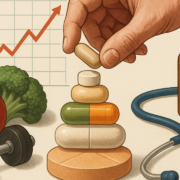The term superfood may seem like a new way to define certain foods worldwide, but in fact, the designation was first used way back in 1918. The first food it was used on? Bananas!
During World War I, the US had just begun importing “copious amounts” of bananas, which were celebrated for their nutrition and digestive properties, so the term was used to spread the word about the benefits of this fruit, and Americans soon followed suit by making them a common part of our daily nutrition.
H2: What Are Superfoods?
Today, whether through marketing, nutrition guides, or shopping at your local market, you’ll see the term used frequently to describe various fruits, vegetables, and other highly beneficial foods. While there is no scientific basis or regulated definition of superfoods, they are typically nutrient-rich foods that offer a host of health benefits – hence, the name. Superfoods are often loaded with antioxidants, vitamins, and minerals and have been linked to improved heart health and brain function, reduced risk of chronic diseases, and a strengthened immune system.
Nonetheless, it’s important to highlight that no food by itself–super or not–offers enough nutrition to satisfy a full diet completely. Incorporating a variety of superfoods onto your plate more regularly can help you achieve greater health benefits and develop more balanced nutrition–it could even help you lose weight!
H2: The 7 Best Superfoods for Your Diet
There are several superfoods worthy of a spot on everyone’s breakfast, lunch, snacks, and dinner plates. Here are a few worth considering:
H3: 1. Berries
All berries are high in antioxidants, which can help protect cells from damage and reduce inflammation. Incorporate blueberries, blackberries, strawberries, and raspberries into your diet regularly for the most benefits.
H3: 2. Avocados
Avocados are a great source of heart-healthy monounsaturated fats. They’re also rich in fiber and antioxidants and have been linked to a reduced risk of several chronic diseases. Add avocado slices to your sandwich or salad for a filling and satisfying meal.
H3: 3. Fatty Fish
Fatty fish, such as salmon, tuna, mackerel, and sardines, are excellent sources of heart-healthy omega-3 fatty acids. These nutrients have been linked to a reduced risk of heart disease, stroke, and arthritis. Aim to eat fatty fish at least twice a week.
H3: 4. Nuts and Seeds
Nuts and seeds are packed with vitamins, minerals, healthy fats, and fiber. They’ve been linked to reduced risk of heart disease and can help improve cholesterol levels. Add a handful of nuts or a sprinkle of seeds to your oatmeal or yogurt for a nutritious boost.
H3: 5. Dark Chocolate
Dark chocolate is loaded with antioxidants that can help lower blood pressure and improve cholesterol levels. When choosing dark chocolate, look for a bar that contains at least 70% cocoa.
H3:6. Leafy Greens
Leafy greens, such as spinach, kale, and collards are low in calories and high in vitamins, minerals, and antioxidants. They’ve been linked to a reduced risk of heart disease, arthritis, and some forms of cancer. Add them to your sandwiches or wraps or enjoy them as a side dish.
H3:7. Greek Yogurt
Greek yogurt is a good source of protein, calcium, and probiotics–live bacteria that can improve gut health. Choose Greek yogurt that is plain and unsweetened for the most benefits.
H2: A Healthy and Balanced Diet
The truth is that the secret to enjoying a healthy and balanced diet relies on incorporating different varieties of foods into your meals, and this can be easily accomplished with superfoods as they excel in being varied. While there’s no need to stock your pantry with every so-called superfood on the market, adding the ones you like best and always having them on hand can help you easily and effectively improve your diet. Over time, having a well-balanced nutritional diet will become easier, and you’ll likely see some key benefits in several aspects of your life.






